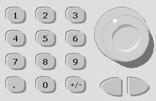

or




Then turn modulation on:



The waveform is output using the present carrier and modulating waveform settings.
[SOURce[1|2]:]AM:STATe{ON|1|OFF|0}
[SOURce[1|2]:]FM:STATe {ON|1|OFF|0}
A modulated waveform consists of a carrier waveform and a modulating waveform. In AM, the carrier amplitude is varied by the voltage level of the modulating waveform. In FM, the carrier frequency is varied by the voltage level of the modulating waveform. The instrument accepts an internal or external modulation source. On a two-channel instrument, one channel can modulate the other.
Select AM or FM before setting up any other modulation parameter. For more information on modulation, see Modulation.










The APPLy command configures a waveform with one command.
The maximum carrier frequency varies by function, model, and output voltage, as shown here. The default is 1 kHz for all functions other than arbitrary waveforms. Arbitrary waveform "frequency" is also set using the FUNCtion:ARBitrary:SRATe command.



The APPLy command configures a waveform with one command.
The instrument accepts an internal or external AM or FM modulation source. On a two-channel instrument you can modulate one channel with the other.
|
|
You cannot modulate noise with noise, PRBS with PRBS, or an arbitrary waveform with an arbitrary waveform. |










The instrument accepts an internal or external modulation source.


 (33500 Series only)
(33500 Series only) 





The modulation depth is a percentage that represents the amplitude variation. At 0% depth, the amplitude is one-half of the carrier’s amplitude setting. At 100% depth, the amplitude varies according to the modulating waveform, from 0% to 100% of the carrier’s amplitude.




The instrument supports two forms of amplitude modulation, "Normal" and Double Sideband Suppressed Carrier (DSSC). In DSSC, the carrier is not present unless the modulating signal has an amplitude greater than zero.





The frequency deviation setting represents the peak variation in frequency of the modulated waveform from the carrier frequency.
When the carrier is PRBS, frequency deviation causes a change in the bit rate equal to one-half of the set frequency. For example, a 10 kHz deviation is equivalent to a 5 KBPS change in bit rate.





The instrument accepts an internal or external modulation source. On a two-channel instrument you can modulate one channel with the other.

|
On the 33600 Series, you can configure the modulation source to accept either a ±5 V signal or a ±1 V signal. See INPut:ATTenuation[:STATe] for details. |
